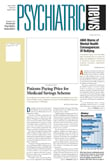Many of today’s psychiatrists have passed through the rite of “taking the boards,” a process marked by intense preparation and the stress of taking oral and written examinations. Today the examination, administered by the American Board of Psychiatry and Neurology (ABPN), is an integral part of a psychiatrist’s education, but its origins 70 years ago were controversial and acrimonious.
In 1928 Dr. Adolph Meyer, in his presidential speech to the APA membership, proposed the creation of a diploma in psychiatry. “The fate of progress depends on minimal standards,” he said in recommending that intensive training should lead to the rewarding of a diploma for special proficiency. Qualifying boards in some medical specialties already existed in Great Britain and in the United States. They had been established in ophthalmology (1916) and otolaryngology (1924), and boards in obstetrics and gynecology (1930) and dermatology (1932) came after Dr. Meyer’s speech.
For several years after Dr. Meyer’s proposal, APA took little action on the matter, although a committee had been appointed to investigate certification. Meanwhile in 1932 the New Jersey Medical Society had begun a state program of specialty certification. Interest was shown by the AMA’s Section on Nervous and Mental Diseases and the National Committee for Mental Hygiene (NCMH). Finally, in his APA presidential address in 1933, Dr. James May said that either APA would have to take action on establishing certification or others would make the decision for psychiatry.
Three organizations agreed to meet: APA, the American Neurological Association, and the AMA’s Section on Nervous and Mental Diseases, with input from the NCMH. The meetings were controversial. Should psychiatry and neurology have a single board or separate boards? The decision for a single board seemed advisable since the American Neurological Association had limited funds and members. And what should the board be called—should psychiatry or neurology be named first?
The American Board of Psychiatry and Neurology was established in 1934, and the first examination was held in 1935. There were 31 applicants. Nine were certified in both psychiatry and neurology, 10 in psychiatry alone, and two in neurology alone; 10 failed.
Controversy again erupted in 1970 when the ABPN abolished the internship incorporating six months of general medical experience within a four-year psychiatry residency. Despite opposition from chairs of psychiatry departments and the APA Assembly, the decision remains.
In an anecdotal history, Dr. Francis Braceland (a psychiatrist and secretary of the ABPN from 1947 to 1951) wrote that during the early years, the neurologists made several unsuccessful attempts to establish a separate board. The psychoanalytic groups made a serious bid to become a subspecialty within the board, but after several years of discussion and disagreements, they withdrew the request.
Other groups within psychiatry and neurology began to press for subspecialty certification. In 1960 the first examination in child and adolescent psychiatry was held, and an examination for child neurology followed. Since then, subspecialty certificates for diplomates in psychiatry were added for addiction psychiatry, clinical neurophysiology, forensic psychiatry, geriatric psychiatry, and pain management.
As of 2000, the ABPN has granted 37,967 certificates in psychiatry and 9,745 in neurology.
Today the ABPN consists of 16 members. The nominating organizations for psychiatry are APA, American College of Psychiatrists, and the AMA; for neurology, they are the American Neurological Association and the American Academy of Neurology. Each of these organizations proposes nominees to serve on the ABPN. The ABPN is independently incorporated. ▪
